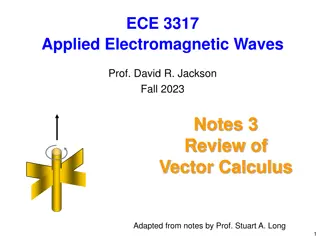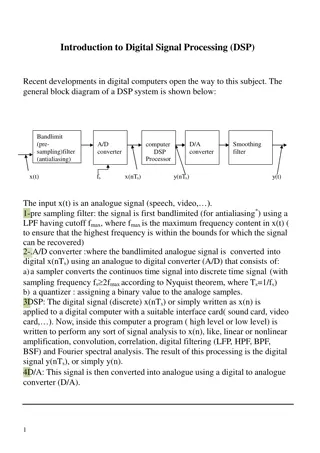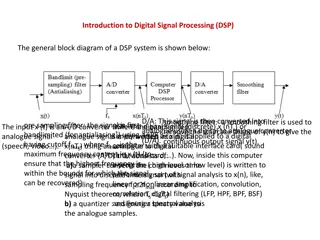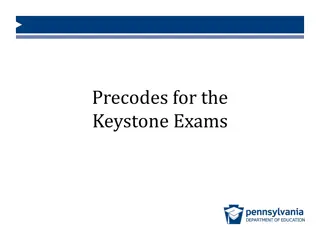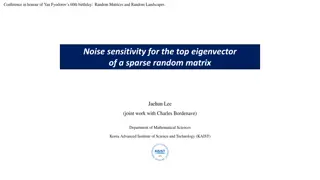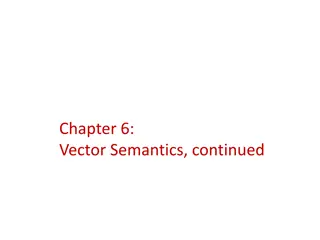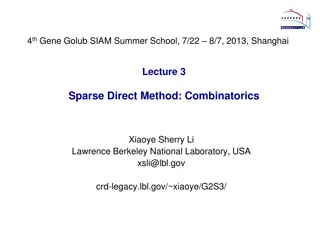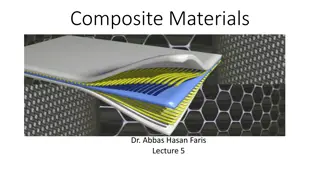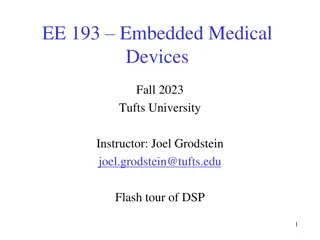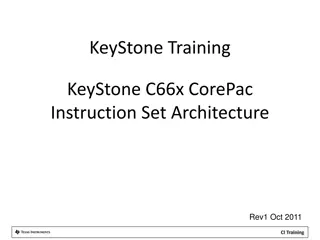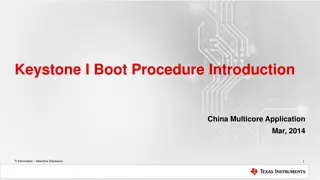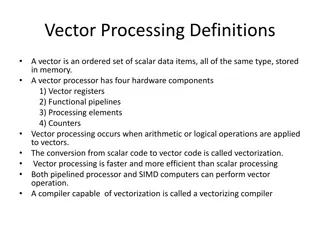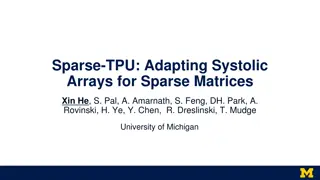Sparse Matrix-Vector Multiply on Keystone II DSP
Sparse matrix-vector multiplication on the Keystone II Digital Signal Processor (DSP) is explored in this research presented at the IEEE High Performance Extreme Computing Conference. The study delves into the hardware features of the Keystone II platform, including its VLIW processor architecture and memory hierarchy. The article discusses the challenges and optimizations involved in VLIW and software pipeline programming, shedding light on the methodology used for evaluating the Keystone II with a Sparse Matrix-Vector (SpMV) kernel. The analysis covers the efficient handling of sparse matrices through compressed formats like Compressed Sparse Row (CSR). Detailed insights into the platform's capabilities, memory hierarchy, and programming techniques are provided for a better understanding of heterogeneous computing on embedded platforms.
Download Presentation

Please find below an Image/Link to download the presentation.
The content on the website is provided AS IS for your information and personal use only. It may not be sold, licensed, or shared on other websites without obtaining consent from the author.If you encounter any issues during the download, it is possible that the publisher has removed the file from their server.
You are allowed to download the files provided on this website for personal or commercial use, subject to the condition that they are used lawfully. All files are the property of their respective owners.
The content on the website is provided AS IS for your information and personal use only. It may not be sold, licensed, or shared on other websites without obtaining consent from the author.
E N D
Presentation Transcript
Sparse Matrix-Vector Multiply on the Keystone II Digital Signal Processor Yang Gao, Fan Zhang and Dr. Jason D. Bakos 2014 IEEE High Performance Extreme Computing Conference(HPEC 14)
Heterogeneous Computing on Embedded Platforms GPU/FPGA/DSP(KeyStone) ARM + Embedded GPUs/FPGA/DSP(KeyStone II) Embedded GPU FPGA DSP Platforms PowerVR SGX 544MP3 Exynos 5 Octa PowerVR G6430 GK20A (Kepler) Zynq-7000 KeyStone II Apple A7 Tegra K1(Jetson) 7Z045 TCI6638 Theoretical Peak Performance (Gflops) 51.1 115.2 @864 MHz 331 65 @1.35GHz 172.8 2
Key Features of KeyStone II In-order execution, static scheduled VLIW processor 8 symmetric VLIW cores with SIMD instructions, up to 16 flops/cycle No shared last level cache 6MB on-chip shared RAM (MSMC) L1D and L2 can be configured as cache, scratchpad, or both DMA engine for parallel loading/flushing scratchpads High performance, Low power consumption design 3
VLIW and Software Pipeline Regular Loop After Schedule for i = 0 to n $1 = load A[i] add $2,$2,$1 A[i] = store $2 endfor L L 7 cycles A L Load 3 cycles A Add 3 cycles S S 3 cycles A L Store 1 cycles S Software Pipeline Restrictions: Not friendly to conditional code inside loop body Register Limitations A VLIW Software Pipelined Loop with static scheduler Rely on compiler to exert the optimization in low level Out-of-order Processor with dynamic scheduler S 4
DSP Memory Hierarchy Size (KB) 32 32 1024 Cache Capacity(KB) 0/4/8/16/32 0/4/8/16/32 0/32/64/128/ 256/512/1024 0 SPRAM Cache L1P L1D L2 SPRAM Cache MSMC 6144 SPRAM Cache 1024K Level 2 SRAM
SPM Method and Double Buffer Time Load 0 Load 1 Load 0 EDMA DSP Corepac Compute 0 Compute 1 Compute 0
Sparse Matrices We evaluated the Keystone II using a SpMV kernel Sparse Matrices can be very large but contain few non-zero elements Compressed formats are often used, e.g. Compressed Sparse Row (CSR) 1 -2 0 -4 0 -1 5 0 0 8 0 0 4 2 0 -3 0 6 7 0 0 0 4 0 -5 val (1 -1 -3 -2 5 4 6 4 -4 2 7 8 -5) col (0 1 3 0 1 2 3 4 0 2 3 1 4) ptr (0 3 5 8 11 13) 7
Sparse Matrix-Vector Multiply Code for y = A x + y conditional execution row = 0 for i = 0 to number_of_nonzero_elements do if i == ptr[row+1] then row=row+1, y[row]*=beta; y[row] = y[row] + alpha * A[i] * x[col[i]] end Low arithmetic intensity (~3 flops / 24 bytes) Memory bound kernel indirect indexing reduction 8
DDR arrays DDR arrays DMA Circular buffer DMA Double buffer for i = elements assigned to current core Product Loop Loop Fission Accumulation Loop i i prod buffer ptr array buffer ptr y y val array buffer col array buffer val col array buffer row x array if(ptr[row+1]-ptr[row])>K if ptr[row] = i then row = row+1 y[row] y[row]* endif y[row] y[row]+acc endif y[row] y[row]* +acc endif y[row] y[row]* +acc endif acc acc+prod[i] if ptr[row] = i then row = row+1 y[row] y[row]* +acc row = row+1 if ptr[row] = i then row = row+1 Adaptive Row Pointer acc acc+prod[i+1] if ptr[row] = i then acc acc+prod[i+k] *val*x acc acc+prod[i] acc acc+prod[i+1] acc acc+prod[i+k] Predicate Instruction 9 Assembly Optimization Manually Unrolled Loop
Buffer Location and Performance Buffer val col ptr y prod Locations L2 MSMC cache map? L1 L2 MSMC cache 10
Matrix 2, 4, 0, 0, 0, 0 5, 4, 7, 0, 0, 0 0, 6, 2, 4, 0, 0 0, 0, 3, 10, 1, 0 0, 0, 0, 4, 6, 8 0, 0, 0, 0, 2, 12 Tri-diagonal N-diagonal 3, 151 11
Buffer Location and Performance Non- zeros per row 3 val col ptr y prod Gflops Norm. Perf Note S S L2 C L2 S C C L2 L2 L2 C S C C C L2 L2 C C L2 L2 C C L2 L2 C C L2 L2 C C L1 L2 S C L2 S L2 C 2.26 1.84 1.23 1.44 3.76 3.55 2.66 2.51 1.57 1.28 0.85 1 1.50 1.41 1.06 1 Best Median Worst2 All cache Best Median Worst2 All cache 151 L1: level 1 SPRAM, L2:level 2 SPRAM, S:MSMC, C:cache 1: The results are normalized to the all cache configuration 2: The worst amongst the configurations with SPRAM 12
Matrix 2, 4, 0, 0, 0, 0 5, 4, 7, 0, 0, 0 0, 6, 2, 4, 0, 0 0, 0, 3, 10, 1, 0 0, 0, 0, 4, 6, 8 0, 0, 0, 0, 2, 12 Tri-diagonal N-diagonal 3, 151 University of Florida sparse matrix collection Matrix Market 13
Testing Platforms Intel i7 3770K MKL Ivy Bridge 25.6 NVIDIA GTX 680 cuSparse Kepler 192.3 NVIDIA Tegra K1 cuSparse Kepler 17.1 TI 6638K2K Arch Memory B/W(GB/s) SPRAM KB/core Single Precision Peak Throughput (Gflops) TDP(W) KeyStone II 12.8 n/a 64/641 64/641 32/1024/7682 448 3090 365 @1.35GHz 172.8(DSP) 44.8(ARM) 77 195 ~10 ~15 1. Register file/allocable share memory or L1 2. L1 SRAM / L2 SRAM / MSMC per core 14
Close Comparison to NVIDIA Tegra K1 Tegra K1 Cortex A15 + Kepler GPU TI 6638K2K Cortex A15 + Keystone II DSP Architecture CPU 4 Cores, 2.2 GHz 32K+32K L1 2M L2 192 CUDA cores @864 MHz 331 Gflops (SP peak) 17.1 GB/s(DDR3-2133) ~ 10 W 4 Cores, 1.4 GHz 32K+32K L1 4M L2 8 DSP cores @ 1.35GHz 172.8 Gflops (SP peak) 12.8 GB/s(DDR3-1600) ~ 15 W Co-processor Memory Bandwidth Power
Kernel/Memory Efficiency efficiency = observed performance/((Arithmetic Intensity) X (Memory Bandwidth)) 18
Conclusion Significant performance gain with loop tuning and SPM optimizations Despite the mobile GPU s higher theoretical SP performance and memory bandwidth, the DSP outperforms it with our SpMV implementation. Auto-decided SPM buffer allocation/mapping by a model of data access pattern. 19
Q & A 20
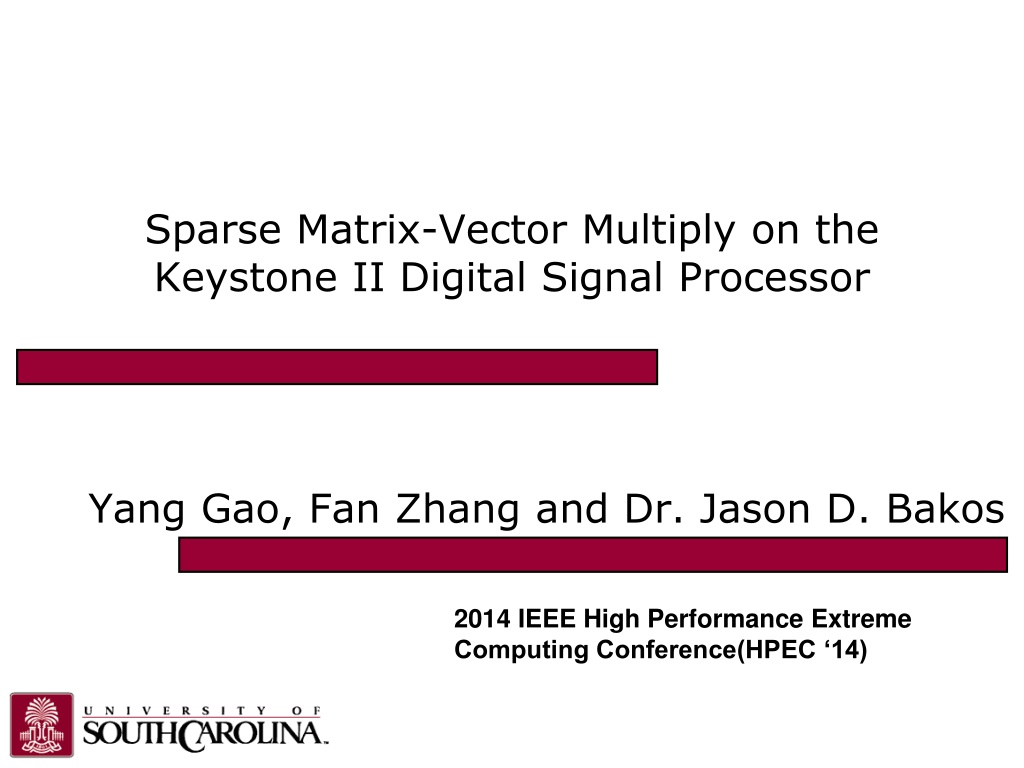
 undefined
undefined










